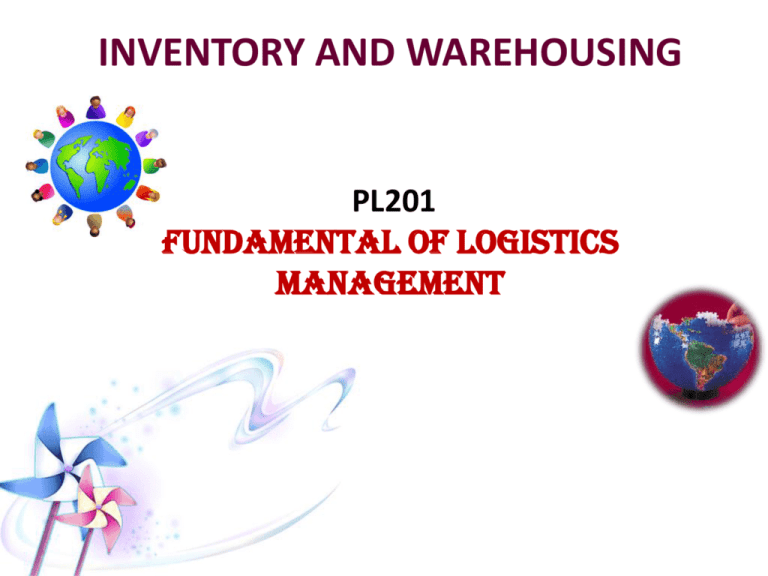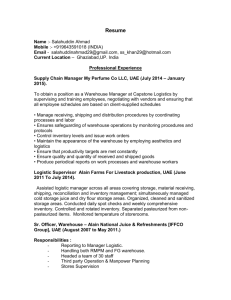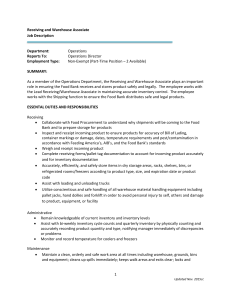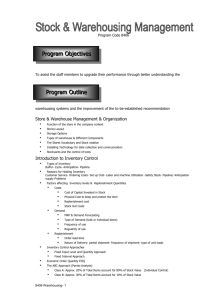basic reasons for warehouse storage requirements
advertisement

INVENTORY AND WAREHOUSING PL201 FUNDAMENTAL OF LOGISTICS MANAGEMENT DEFINE THE CONCEPT OF INVENTORY MANAGEMENT IN SUPPLY CHAIN AND LOGISTICS ACTIVITIES Inventory refers to the stockpile of the products a firm would sell in future in the normal course of business operations and the components that make up the product. The firm stores three types of inventories, namely, raw materials, work-in-process/ semi-finished goods and finished good. TYPES OF INVENTORY DEMAND Types of Inventory Demand Explanation Perpetual Demand Require continual or period replenishment. Deals with products that have a significant demand for a very long period of time. Inventory management is directed as forecasting the level of demand that will occur for each item when and quantity of stocks to be replenished. Seasonal Demand May involve products that are demanded at certain period of the year or require accurate forecasting the level of demand that will occur. Lumpy Demand This type of demand will occur due to drastic environment or lifestyle change. It is quite difficult to predict quite accurately of the coming demand trend. Close monitoring of the erratic or lumpy demand with slow response in product replenishment. TYPES OF INVENTORY DEMAND Types of Inventory Demand Explanation Terminating Demand This is more of a planned preparation. Demand will decline and excessive inventories can be worked out slowly. The focus of the planning is when and how much should be stocked during each period (week, month or year) with preparation towards the termination period specified. Derived Demand The demand for this category of products is derived from the final consumer market. How much and when to order or produce can be accurately determined from monitoring the demand for finished products. THE PURPOSE IN INVENTORY Improve Customer Service • Having inventories will ensure that customer who desire or must have immediate stock availability or short delivery times are satisfied in their dealing with the firm. This measure assists the marketing department and specifically the level of customer service to the customers. Encourage Production Economies • Items purchased or manufactured in quantities greater than what is needed immediately will create lot-size inventories. This is to take advantage of quantity discounts, to reduce shipping, clerical, setup costs and in some cases, where it is impossible to make or purchase items at the same rate it will be used or sold. Permit Purchase and Transportation Economies • Inventory acts as buffer between demand and supply so that production can be geared to a more constant output than fluctuating demand. Therefore, lowest per-unit cost is possible due to the fact that production runs at a constant quantity. • Inventory will also allow the seizure of lower per-unit rates of fullvehicle-load quantities. Likewise, lower prices can also be realized from price-quantity discount offer as more can be purchased and inventoried. THE PURPOSE IN INVENTORY Act as Hedge against Price Changes Protect against Uncertainties in Demand and Lead Time Act as a Hedge against Contingencies • Goods that are purchased on the open market are subject to the price level s dictated by changing supplydemand pattern. Purchases may be made in advance of need because of anticipated price increases. • In most cases, the level of demand on a logistics system and the time required for re-supply cannot be known for sure. To assure product availability, additional amounts of stock are maintained. These stocks are in addition to the regular stock to meet production and marketplace needs. • Labour strikes, fire and floods are just a few of the contingencies that can happen. Therefore, maintaining backup inventories is one way in which normal supplies can be maintained for a period of time. OBJECTIVES OF INVENTORY MANAGEMENT The objectives of inventory management consists of two counterbalancing parts: • to minimize investments in inventory and to meet the demand for products by efficiently organizing the production and sales operations. • In operational terms, the goal of inventory management is to have a trade-off between these two conflicting objectives which can be expressed in terms of costs and benefits associated with different levels of inventory. THE IMPORTANCE OF WAREHOUSE STORAGE • Trade - Without warehouse facilities it would be very difficult to ship goods produced in Washington, such as agricultural commodities, lumber and wood products, and aluminum, out of the state. Warehouses are also essential to importers. • Storage/Distribution of Goods - Warehouses are utilized by retailers and wholesalers for the goods that they buy and sell. Manufacturers use warehouses to store raw materials and finished products. • Expansion of Markets - By locating warehouse facilities in different parts of the state, firms can expand beyond their own local markets. • Small Firms - The use of warehouse facilities gives small firms the opportunity to grow without large capital investments and one warehouse can service many small firms BASIC REASONS FOR WAREHOUSE STORAGE REQUIREMENTS Basic Reasons for Warehouse Storage Requirements Explanation Transportation-Production-Cost Reduction Products originate from many sources. By stocking inventories, the supplying and distributing transportation and production costs will be lowered. Coordination of Supply and Demand For highly seasonal production coupled with constant demand for products. Warehousing is highly needed to coordinate supply and demand and to avoid excessive costs incurred due to production and transportation. Production Needs For products that needs to be stored for a certain period before consumption period begins for example, cheese. Marketing Considerations Fast delivery that can satisfy customers requires stock availability through stocking in warehouse. WAREHOUSE ACTIVITES a. Receive goods – the warehouse accepts goods from outside transportation or an attached factory and accepts responsibility for them. This means that the warehouse must check goods against an order and the bill of lading, check the quantities, check for damage and fill out damage report if necessary and inspect goods if required. b. Identify the goods- items are identified with the appropriate stock-keeping unit (SKU) number and the quantity received recorded. c. Dispatch goods to storage – where goods are sorted and stored away. d. Hold goods – where goods are kept in storage and under proper protection until needed. WAREHOUSE ACTIVITES d. Pick goods – items required from stock must be selected from storage and brought to a marshalling area. e. Marshal the shipment – where goods making up a single order are bought together and checked for omissions or errors. Order records are updated. f. Dispatch the shipment – where the orders are packaged, shipping documents prepared and goods loaded on the right vehicle. g. Operate an information system – a record must be maintained for each item in stock showing the quantity on hand, quantity received, quantity issued and location in the warehouse.




